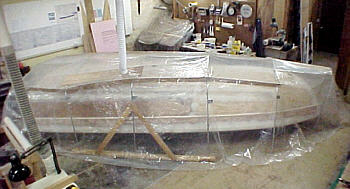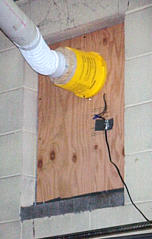 With
the trailer nearing completion the fact that I wasn't working on the Cabin
Skiff was driving me nuts. It has been two months since I stopped
and I have mixed no epoxy since then. Still I seem to have a reaction
whenever I spend two days in a row working in the shop. It is slight,
but something is going on. Also, the "rash" on my neck and
hands looks a little better but is still there. I had hoped it would
disappear but no such luck. With
the trailer nearing completion the fact that I wasn't working on the Cabin
Skiff was driving me nuts. It has been two months since I stopped
and I have mixed no epoxy since then. Still I seem to have a reaction
whenever I spend two days in a row working in the shop. It is slight,
but something is going on. Also, the "rash" on my neck and
hands looks a little better but is still there. I had hoped it would
disappear but no such luck.
To make matters worse we have had a unseasonably warm week and I half with temperatures in the upper 60's (not normal February temps in Illinois). I decided I HAD to figure out a solution to the problem of fumes collecting in the building where I am building the CS AND work 9 hours a day during the week so I could get back at it.
I then covered it with a large sheet of fairly heavy plastic. This should help contain the fumes but still I need to get rid of them - some type of exhaust system. As you can see from photos of my shop I am some what of a "junk" collector. In fact under the shop is a full basement and I have even more "serviceable used items" stored down there! I went down and scrounged around and found an old fan that I had salvaged of a dead refrigerator. It had a 7" blade, ran at a fairly slow RPM and was very quiet. I really wasn't looking for high volume just a low constant flow that would cause negative air pressure under the plastic and hopefully expel the gas that is causing me problems.
With this done it is time to put it to the test. The bottom of the
hull is ready to have the fiberglass added so I will do the first half
this weekend and then the other side next weekend. It will then need
to set for about 3 weeks for it to totally cure before I can paint.
Link to Building The Glenn-L Series 1700 Trailer pages |
|
|
 After
a little head scratching I had an idea. I decided to build a removable
tent over the hull. I used ½" metal electrical conduit and
bent it to form six supports. The center one is setting on 2x4 and I used
two diagonal supports to make it free standing. I then connected the other
conduit supports using strips of scrap ¼" OSB. The one end
has a hole drilled and the conduit is run through it.. The other
end has a crude locking slot that just slips over the conduit. This
allows me to to quickly set it up or tear it down. The only fasteners
are two wing nuts used to hold the diagonal braces in place on the side
of the conduit. With two people it sets up in about 3 minutes.
After
a little head scratching I had an idea. I decided to build a removable
tent over the hull. I used ½" metal electrical conduit and
bent it to form six supports. The center one is setting on 2x4 and I used
two diagonal supports to make it free standing. I then connected the other
conduit supports using strips of scrap ¼" OSB. The one end
has a hole drilled and the conduit is run through it.. The other
end has a crude locking slot that just slips over the conduit. This
allows me to to quickly set it up or tear it down. The only fasteners
are two wing nuts used to hold the diagonal braces in place on the side
of the conduit. With two people it sets up in about 3 minutes.
 The
shop is an old brick building and there is only one window located near
the ceiling at the back which is about 50' away. I used 4" DWV plastic
pipe (I use the same stuff for my dust collection system in the shop) as
my duct which I hung from the ceiling with wire. On the boat end I dropped
down with 4" flexible dryer vent. On the other end I mounted the
fan on a piece of plywood cut to fit the window. To it I bolted a
small plastic bucket to serve as a reducer from the 7" fan to the 4" pipe.
Crude, yes, but I think it will work and it was cheap. It doesn't
move a lot of air but I don't need it to. I plan to let it run 24
hours a day - time will tell.
The
shop is an old brick building and there is only one window located near
the ceiling at the back which is about 50' away. I used 4" DWV plastic
pipe (I use the same stuff for my dust collection system in the shop) as
my duct which I hung from the ceiling with wire. On the boat end I dropped
down with 4" flexible dryer vent. On the other end I mounted the
fan on a piece of plywood cut to fit the window. To it I bolted a
small plastic bucket to serve as a reducer from the 7" fan to the 4" pipe.
Crude, yes, but I think it will work and it was cheap. It doesn't
move a lot of air but I don't need it to. I plan to let it run 24
hours a day - time will tell.